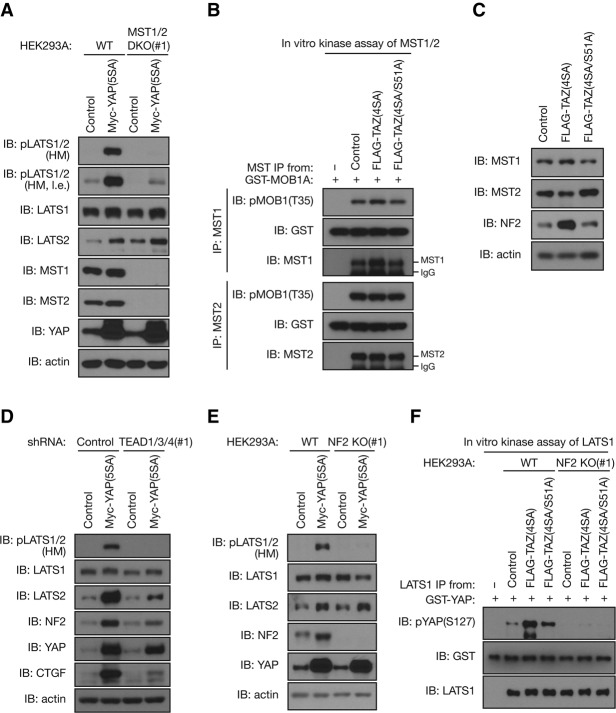Figure 4.
YAP and TAZ stimulate the intrinsic kinase activity of LATS1/2 through NF2. (A) MST1/2 are largely required for YAP-induced LATS1/2 activation. Wild-type (WT) and MST1/2 double-knockout (DKO) HEK293A cells infected with retroviruses encoding Myc-YAP(5SA) or with control empty retrovirus were subjected to immunoblot (IB) analysis. (l.e.) Long exposure. (B) TAZ does not stimulate MST1/2 kinase activity. Endogenous MST1 or MST2 was immunoprecipitated (IP) from MCF10A cells infected with retroviruses encoding Flag-TAZ(4SA) or Flag-TAZ(4SA/S51A) or with the empty retrovirus (control). The resulting immunoprecipitates were subjected to in vitro kinase assay. (C) TAZ increases NF2 abundance. MCF10A cells infected as in B were subjected to immunoblot analysis. (D) TEADs are required for NF2 induction and LATS1/2 activation by YAP. MCF10A cells stably expressing Myc-YAP(5SA) or control vector were infected with lentiviruses encoding shRNAs specific for TEAD1/3/4. Immunoblot analysis was performed with the indicated antibodies. (E) NF2 is required for YAP-induced activating phosphorylation of LATS1/2. Wild-type and NF2 knockout (KO) HEK293A cells infected with retroviruses encoding Myc-YAP(5SA) or with control empty retrovirus were subjected to immunoblot analysis. (F) NF2 is required for TAZ-induced LATS1 activation. Endogenous LATS1 was immunoprecipitated from wild-type or NF2 knockout HEK293A cells stably expressing Flag-TAZ(4SA), Flag-TAZ(4SA/S51A), or control vector. The resulting immunoprecipitates were subjected to in vitro kinase assay. See also Supplemental Figure S4.

